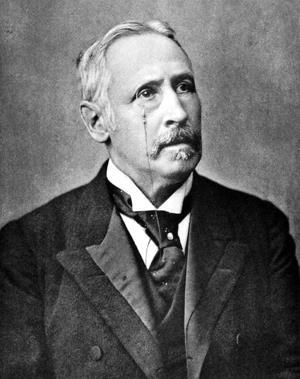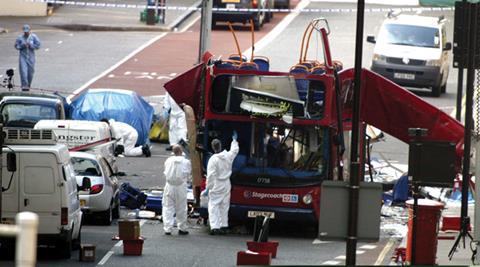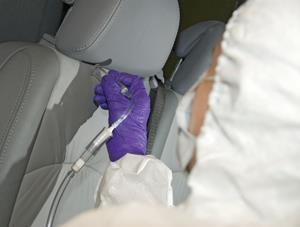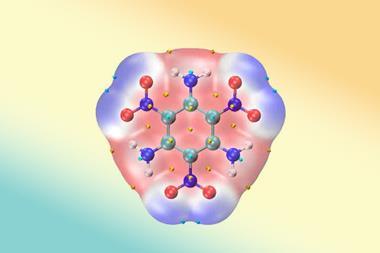The Forensic Explosives Laboratory supports police investigations into unlawful use of explosives. Philip Robinson reports from Fort Halstead

In the corridors of a squat utilitarian laboratory block, surrounded by rooms full of high-tech apparatus, hangs a portrait of a rather distinguished Victorian gentleman. Monocled and moustached, his impassive gaze looks out over a starched white collar and cravat. The image might seem somewhat out of place, but a quote accompanying the picture reveals more about the man, and about the facility that now houses his likeness: here is an expert in ‘infernal machines’. Put simply – bombs.
The gentleman is Vivian Majendie who, in the late 19th century, became one of the world’s first bomb disposal specialists. Working during one of the first terrorism campaigns conducted in the UK, he investigated a string of dynamite bombings orchestrated by the Irish Republican Brotherhood, personally disarming an infernal machine found at Victoria Station in London.
But Majendie’s legacy is much greater than his individual acts of heroism, for he also laid the foundations of the Forensic Explosives Laboratory (FEL) where his portrait now hangs, 130 years later. And where today the FEL’s forensic specialists continue to support the UK’s police force investigating incidents of explosives, from terrorist activities to fireworks in phone booths.
‘The Forensic Explosives Laboratory is funded by the Home Office to provide the UK police services and the criminal justice system with forensic services to investigate any criminal activity relating to explosives,’ says the lab’s capability leader, who looks after developing the lab’s technical capability and its external collaborations. Located in Fort Halstead in Kent, the lab is part of the UK Defence Science and Technology Laboratory (DSTL) and is the only place in mainland UK that can carry out forensic explosive investigations (Northern Ireland hosts its own dedicated facility).
Does it burn?
In their basic construction, Majendie’s infernal devices have changed little in the intervening years – the physics of explosion remain the same. But the analytical techniques available today would no doubt be astonishing to him; tools that allow the FEL’s scientists to identify specific explosives from even invisible traces of material.

The lab has 20 staff members, who are ready at all times – regardless of the hour of the day, or day of the year – to analyse samples from police forces across the country. These samples contain everything from fragments of devices, to unknown powders or cotton swabs from crime scenes. Every aspect of the laboratory is designed to ensure that whatever the sample may be, it is handled safely. Humid conditions reduce friction between crystals, and conducting floors prevent any charge build up and the potential for sparks that could detonate an explosive. ‘There’s a difference between handling military hardware, which has been constructed to a particular standard as compared to something that somebody’s manufactured in their garage,’ explains one of the lab’s senior forensic analysts. None of the scientists can be identified in this article because they act as expert witnesses in court cases.
Once the sample has arrived, the process of identification begins. The team first assesses its appearance, whether it’s a powder or fragments from debris that has been blown up for example, and decides what analysis could be done on it. But before the sample reaches the lab’s battery of high-tech analytical artillery, some more mundane tests that might be familiar to Majendie still have their place.
‘If it’s a powder, we always burn it first,’ says one of the junior forensic analysts. ‘It’s very primitive and rudimentary, but it’s a good technique, if you can call it that.’ The test reveals whether a material is energetic, and may provide other clues to a sample’s identity. ‘Black powder [a component of gunpowder], has sulfur in it, so you get a smell of eggs. As well as a lilac flame colour from the potassium [nitrate],’ he continues.
A suite of spectroscopic and chromatographic techniques are then applied. The techniques used must complement one another, each corroborating the analysis provided by another, explains the senior forensic analyst. ‘So for example, if you suspect it’s black powder, IR [infrared] will give us nitrate. Then our scanning electron microscope has an energy dispersive spectrometer that will identify the potassium and sulfur, and the carbon that might be present from charcoal. The final piece of analysis would be ion chromatography to confirm the presence of the nitrate and the potassium.’
Black powder is one of the most common materials the lab receives. But potassium nitrate has many more uses than as an explosive fuel, and the police can’t arrest someone for being a keen gardener using nitrate fertiliser for example. So the FEL must provide police with all the information they need to assess the significance of a chemical too.
Going to court
‘If you find a military explosive that can be very significant,’ explains the senior forensic analyst. No member of the public could accidently come into contact with a military-grade explosive – such as dynamite or trinitrotoluene (TNT) – so their presence is an immediate red flag. However, substances such as hexamine, citric acid and hydrogen peroxide are less clear cut. ‘Maybe they have a camping stove, or a home brewing hobby, or there is a hairdresser living at the property. But they’re also the three precursor chemicals for the manufacture of [the common home-made explosive] HMTD [hexamethylene triperoxide diamine].’ In these cases, the context may provide the police with more information, but ultimately the FEL must give police a balanced assessment to safeguard the judicial system’s impartiality.
The results obtained in the FEL could potentially lead to someone being imprisoned, which means that the forensic analysts need to know their analysis is as accurate as possible. All of their protocols are approved and accredited by the UK Accreditation Service, but the scientists must also know the limitations of their analyses and where uncertainties may lie, because they could be asked to take the stand in court to provide expert witness under oath. This responsibility relies on knowing the techniques inside out and years of experience working with explosives. ‘[In court] we might be asked about details of chemistry, but not very often. Usually we’ll be asked what the chemicals could be used for or “how is the explosive made?” and what sort of effect could [a device or chemical] have, and then we draw on experience from our explosives trials and training,’ says the senior forensic analyst.
This all means the team must use established, reliable analytical techniques rather than nascent methods that have not yet been proven. But that doesn’t mean there’s no R&D taking place.
Developing capability
For although the construction of an explosive device has changed little since Majendie’s day, the specific chemicals used, and therefore the analysis needed to identify them, does change. Through the years of the Irish Republican Army campaign on the UK mainland, devices used military-grade explosives and the FEL developed expertise detecting specific analytes for these. ‘But nowadays, the threat is more from improvised explosives,’ says the analyst who leads the group’s forensic research programme. And as bomb builders alter their methods, the FEL must respond, sometimes in very short order.

This occurred in drastic fashion when London’s public transport system was targeted by terrorists on 7 July 2005. Buses and underground trains were targeted in a coordinated attack that killed 52 people and injured hundreds. FEL’s experts were immediately involved, but they faced an unfamiliar situation.
‘The type of explosives used were relatively new to us,’ says the capability leader. ‘We had to undergo a very rapid and very intense R&D process to try and help us understand the properties of the explosives they used.’ This demanded rapid knowledge gathering, not only to develop identification methods but to understand the material itself. ‘We had to demonstrate that [the chemical] was viable as an explosive for the courts,’ the capability leader adds, ‘and how it might have been used in a device, and the damage it could cause.’
Devising a bomb’s construction from its exploded fragments is difficult, but an unexploded device from the subsequent bombings on 21 July helped investigators understand how the devices were built. In this case, a catering tub filled with flour and hydrogen peroxide, bound in sticky tape with metal washers – a simple, but potentially devastating, device. ‘We had to actually go out and do a large-scale trial where you’re making these devices and setting them off and seeing the properties,’ explains the capability leader. This field test allowed the team to quickly accumulate evidence that led to the convictions of the bomber’s conspirators.
The FEL also contributes its knowledge to a network of global forensic explosives experts – an essential resource to stay abreast of new threats. And collaborations with academia also support the group’s efforts to adapt to new threats. But the need for a different approach has also become clear – a need to work more flexibly, with the ability to respond and predict.
‘Most of our development work is about taking our existing methods and making them work on state-of-the-art kit,’ explains the analyst who leads the forensic research programme. ‘Currently, when we get a sample, we look for a large number of materials that are of interest, screening against known compounds. But very occasionally, you meet a new compound, such as in the London bombings.’ For these cases, the FEL is looking to mass spectrometry. ‘A lot of people are surprised we don’t use mass spec routinely,’ explains another senior forensic analyst, ‘but explosives are generally small molecules and well known, so it’s not necessary’. But the capability of high-resolution mass spectrometry could provide the FEL with the flexibility it needs.
‘Now, instead of looking at specific analytes, we have the potential to search for families or classes of analytes,’ the capability leader elaborates. ‘And with high-resolution mass spectrometers that acquire all information about all analytes passing through the system, you can use clever technology and software to back-interrogate the data. So if there’s something there that you might not specifically be looking for, you can go back later and find it.’
Trace elements

Of course, the typical outcome of an explosion may leave little sample to assess. But in the aftermath of an explosion there is still a wealth of evidence the FEL can extract. That’s where the trace laboratory comes in.
The trace lab’s chromatographic and spectroscopic tools are needed to detect the smallest quantities of explosive, either after the event, or in pursuing an investigation around an event or suspect. ‘An explosion doesn’t involve just the scene of the explosion itself,’ explains the trace laboratory’s manager. ‘It might involve sampling a premises where a terrorist was based, or sampling the terrorist’s car and clothing.’ Or, indeed, anything that might hold some useful chemical clue: ‘Blown up washing machines, fridges, cash machines, lamp posts, forklift trucks… you name it; we’ve swabbed it,’ he continues.
The trace lab detection limits are impressive – a capability of about 1ng: ‘30,000 times smaller than a grain of sugar’. But although lower thresholds are feasible, the FEL must balance sensitivity with accuracy to provide information that can be deemed significant. ‘Somebody has to be prepared to stand up in court and say, “This trace has significance” and that is a different question. So our drive has not been to sensitivity, but rather to selectivity,’ he continues.
The trace lab is also something of a paradox. ‘To measure trace levels of explosives there must be no threat of any contamination, which means it must be an explosives-free environment,’ he says. Maintaining the lab’s integrity, on a site that holds and receives explosive samples every day, is no mean feat – rigorous quality assurance establishes that the lab is completely clean after every use. ‘We swab all the benches twice [after cleaning] and then 14 marked floor areas that, even if you had the agility of a cat, you couldn’t avoid.’ All of this attention to detail does however take its toll after 18 years in the post: ‘The washing up [at home] does take a lot longer than it used to.’
Moving home
These stringent requirements also pose a far greater challenge should the trace lab ever be relocated. And soon it will. By 2018, the entire FEL will be in its new home at the DSTL’s principal research site – Porton Down.
Planning the relocation of the lab is a logistical challenge that is keeping the group member who manages the team of support staff very busy. ‘Any forensic science laboratory is about the integrity and continuity of the items that you’re depositing, securing, and examining,’ he explains. Ensuring the integrity of samples, and continuing to provide service as the lab relocates poses significant challenges, but the facility’s greatest asset is its staff. An instrument can be adapted, protocols implemented and equipment procured, but the knowledge of the forensic analysts takes years of training and constant development. ‘That’s our most important resource,’ he continues. And so in that respect, the move presents a further risk, that lab members may choose not to relocate. ‘And that’s tricky, because it’s emotive – it’s not just changing the way we work, it’s moving home,’ he continues. ‘But the good thing is this is very much a vocation; people are enthused and engaged with their work.’ The capability leader concurs: ‘It’s very much a career, we nurture them. But when they do leave, that can leave big holes in the capability.’
The staff training is therefore paramount, and involves a schedule of development and progression that runs right from entry level graduates to the group’s most senior members. ‘We’re like the fire service – our staff need to maintain their expertise so they can be on tap to provide a rapid response,’ says the group leader. ‘That progression underpins our capability, because it takes at least four years to produce and nurture a forensic court-going officer.’
For the investigators, it’s clearly more than just a job, and their dedication is an admirable tribute to Majendie’s legacy. One of the senior forensic analysts sums it up: ‘There’s a great focus on scientific investigation here – ensuring we can support the criminal justice system efficiently and effectively. It gives you the feeling that you’re assisting some greater cause; it’s a really worthwhile job.’












No comments yet